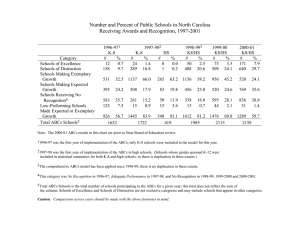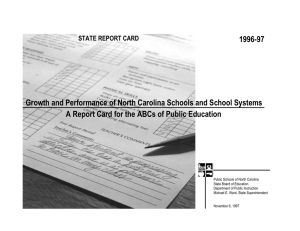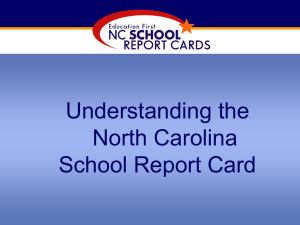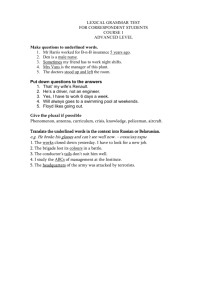The ABCs of Public Education: Sections Executive Summary
advertisement
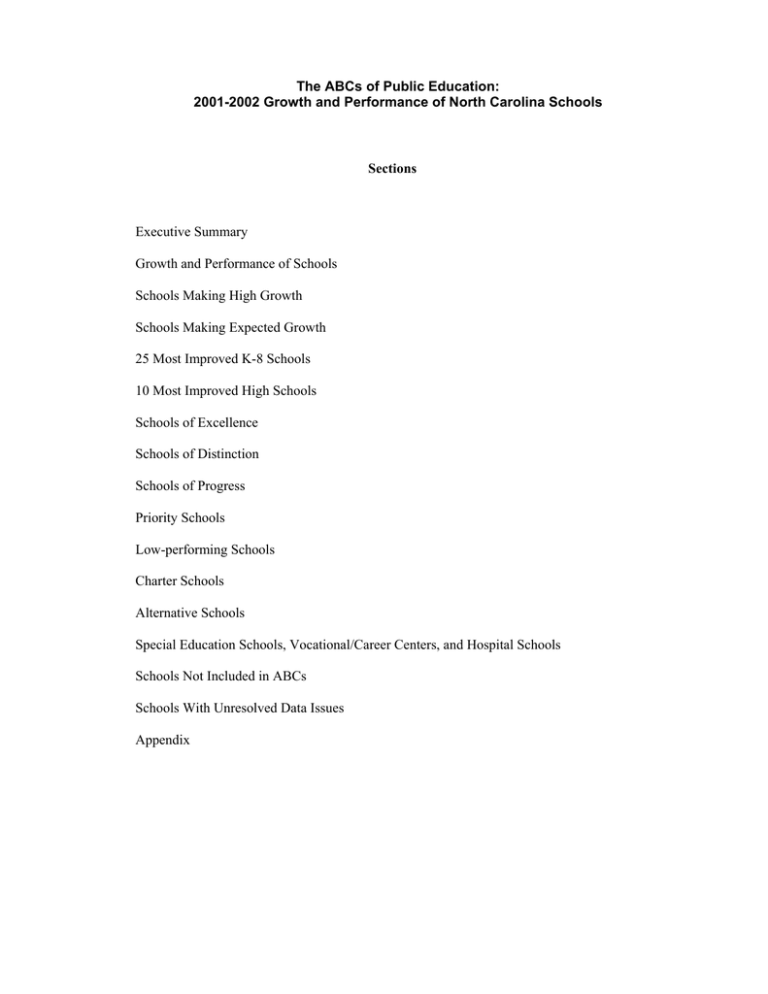
The ABCs of Public Education: 2001-2002 Growth and Performance of North Carolina Schools Sections Executive Summary Growth and Performance of Schools Schools Making High Growth Schools Making Expected Growth 25 Most Improved K-8 Schools 10 Most Improved High Schools Schools of Excellence Schools of Distinction Schools of Progress Priority Schools Low-performing Schools Charter Schools Alternative Schools Special Education Schools, Vocational/Career Centers, and Hospital Schools Schools Not Included in ABCs Schools With Unresolved Data Issues Appendix The ABCs of Public Education: 2001 - 2002 Growth and Performance of North Carolina Schools Key to Status Abbreviations and Codes Used in the ABCs Report Status Abbreviations Hgh Exp MI MI Exc Dst Pro Pri NR LP EE 98R 95R School Making High Growth School Making Expected Growth 25 Most Improved K-8 Schools 10 Most Improved High Schools School of Excellence School of Distinction School of Progress Priority School No Recognition Low-Performing Excessive Exclusions Less than 98 percent tested Less than 95 percent tested Special Codes 1 2 3 9 K-2 feeder school Senior high school – grades 9-12 option Senior high school - grades 10-12 option School did not meet data requirements * Confidence interval applied ii The ABCs of Public Education: 2001 - 2002 Growth and Performance of North Carolina Schools Executive Summary Background The State Board of Education (SBE) developed the ABCs of Public Education in response to the SchoolBased Management and Accountability Program enacted by the General Assembly in June 1996. The ABCs focuses on: strong accountability; teaching the basics with an emphasis on high educational standards; and maximum local control. The first ABCs accountability model was implemented in elementary and middle schools in 1996-97. A high school accountability model was developed during 1996-97, and was implemented for the first time in 1997-98. In 1998-99 the two models were combined into one comprehensive ABCs model for elementary, middle and high schools. In 1999-2000 this model was implemented again, augmented by a new policy for participation of alternative schools. Additionally, the 1999-2000 accountability year was the first year of reporting ABCs results for schools that are administered by the Department of Human Resources and the Department of Juvenile Justice and Delinquency Prevention. In the 2000-2001 school year, the ABCs accountability model was fine-tuned in response to input from schools and school districts, actions of the SBE, and experience with previous years’ ABCs. Modifications included the implementation of End-of-Course (EOC) prediction formulas for the 10 multiple choice EOC tests, the weighting of growth composites, the use of an equating study (described in the technical notes) to include new mathematics test results in the ABCs (both growth and performance), and the removal of writing at grades 4 and 7 from the growth composite. For the 2001-2002 school year, the accountability model was further modified to reflect the following: a) using mathematics equating for both pre and post test mathematics scores; b) removing Writing at grades 4 and 7 from the performance composite; c) adding the North Carolina Alternate Academic Assessment Inventory (NCAAAI) reading and mathematics results to the performance composite; d) removing the Grade 10 North Carolina High School Comprehensive Test (NCHSCT) from the ABCs model; e) and refining the scoring process for the North Carolina Alternate Assessment Portfolio (NCAAP) with results added in the performance composite for ABCs based on the total portfolio scores rather than the four domain scores. f) At the May 2002 State Board of Education Meeting, the Board adopted new reporting categories for the ABCs. Two new categories were added, Schools of Progress and Priority Schools. The Board also renamed Exemplary Growth to High Growth and now requires Expected Growth for Schools of Distinction The ABCs accountability program sets growth and performance standards for each elementary, middle, and high school in the state. End-of-grade (EOG) and End-of-Course (EOC) test results and selected other components are used to measure the schools’ growth and performance. Schools that attain the standards are eligible for incentive awards or other recognition (including Schools of Excellence, Schools of Distinction, Schools of Progress, 25 Most Improved K-8 Schools or 10 Most Improved High Schools). Priority Schools is a new category to denote schools that may benefit from voluntary assistance provided by the SBE. To be eligible for incentive awards, schools also must not have excessive exclusions from testing and must test at least 98% of their eligible students in K-8, and at least 95% of students enrolled in specific courses in high school. Schools where growth and performance fall below specified levels are designated as low-performing, and may receive mandated assistance based on action by the SBE. iii The ABCs of Public Education: 2001 - 2002 Growth and Performance of North Carolina Schools Participating schools In 2001-2002, every school that contained one or more of the grades 3-12 and that submitted the appropriate data participated in the ABCs. K-8 schools’ data include test results in reading and mathematics; computer skills at grade 8; NCAAP; reading and mathematics from the NCAAAI, and EOC tests if the subject(s) were taught in the school. High schools’ data include EOC test results, percent of students completing College University Prep/College Tech Prep courses of study, change in ABCs dropout rates, and change in competency passing rates. K-2 schools sending more than half of their students to a single receiving school were eligible for incentive awards if the receiving school earned an incentive award based on making its growth standard. Alternative schools follow a special plan of inclusion in the ABCs. Accountability in these schools is based on achievement data (EOC, EOG, competency passing rates) and on three locally selected accountability measures. These “local options” are selected objectives that are specified on school improvement plans and approved by the local boards of education. The status and incentive awards for alternative schools were determined using the criteria specified in State Board of Education Policy HSPC-013. Results are reported here in a special section for alternative schools. Special education schools, vocational/career centers and hospital schools were considered for incentive awards based on the performance of the schools they served. They received prorated incentive awards on this basis. These schools appear in a special section of the report. Analyses The status of schools and incentive awards were determined by the values of three weighted composite scores in the ABCs. They are the expected growth composite, the high growth composite, and the performance composite. These composite scores consisted of many components, depending on the grade span and courses offered in the school, as follows. Expected growth composites include as many of the following as apply in a given school: growth in EOG reading and mathematics for grades 3-8 based on three factors: statewide average growth, the previous performance of students in the school, and a statistical adjustment which is needed whenever test scores of the same students are compared from one year to the next, growth in high school EOC performance based on EOC prediction formulas change over a two-year baseline in the percent of students completing college university prep/college tech prep courses of study, change from grade 8 to grade 10 in the competency passing rate, change over a two-year baseline in ABCs dropout rates. High growth composites include as many of the above as apply in a given school. However, the high growth standard factors in an additional ten percent above the statewide average growth for grades 3-8, and an additional 3% above the statewide average used in the EOC prediction formulas. There is no high growth standard for the competency passing rate, the change in the percent of college university prep/college tech prep completers or the change in ABCs Dropout rates. The performance composite is based on the percentage of scores at Achievement Level III or above in EOG reading, EOG mathematics, NCAAP, reading and mathematics components from the NCAAAI, iv The ABCs of Public Education: 2001 - 2002 Growth and Performance of North Carolina Schools Computer Skills Test at grade 8, and EOC courses (Algebra I and II; Biology; Chemistry; English I; Economic, Legal, and Political Systems (ELPS); Geometry; Physical Science; Physics; and U.S. History) in the schools where taught. The Algebra I scores of ninth graders who took Algebra I prior to ninth grade are included in the high school’s performance composite. (See Technical Notes in the Appendix for an explanation of how scores are handled in senior high schools and also for how the NCAAP/NCAAAI scores are included). The ABCs results published here were produced on a Compaq Model EVO W4000 computer, Pentium 4 1.7 GHz processor with 1024 MB RAM running under Microsoft Windows NT V. 4.0. Additional detail and technical information about ABCs analyses are provided in the Appendix. Definition of Awards and Recognition Categories Schools were classified into several categories for the purposes of incentive awards and recognition. The award or recognition a school receives is determined in most cases by the school’s attainment as reflected in the growth composites (expected or high) and the performance composite. (Exceptions include K-2 feeder schools, alternative schools, and special schools). The categories are defined as follows. Schools Making High Growth These schools attained their high growth standard. They will receive a certificate and incentive awards. Incentive awards for making high growth are $1500 per person for certified staff and $500 per person for teacher assistants. Schools Making Expected Growth These schools attained their expected growth standard (but not their high growth standard). They will receive a certificate of recognition and financial awards. Incentive awards for making expected growth are $750 per person for certified staff and $375 per person for teacher assistants. 25/10 Most Improved Schools The 25 Most Improved K-8 schools are those that attained the State’s 25 highest values on the high growth composite. The 10 Most Improved High Schools attained the State’s 10 highest values on the high growth composite. (Any school with a combination of grades which includes grade 9 or higher was eligible for the high school recognition rather than the K-8 recognition.) These schools will receive a dated banner to hang in the school, a certificate and financial awards. Schools of Excellence A School of Excellence is a school that made at least expected growth and had at least 90 percent of its students’ scores at or above Achievement Level III. Such schools will receive a dated banner to hang in the school and a certificate. In addition, they will receive whatever incentive award they earn as having made expected or high growth. Schools of Distinction A School of Distinction is a school that made expected growth and had at least 80 percent of its students’ scores at or above Achievement Level III (but does not qualify as a School of Excellence). Schools of Distinction will receive a plaque and a certificate. In addition, they will receive whatever incentive award they earn as having made expected or high growth. v The ABCs of Public Education: 2001 - 2002 Growth and Performance of North Carolina Schools Schools of Progress A School of Progress is a school that made expected growth and had at least 60 percent of its students’ scores at or above Achievement Level III (but does not qualify as a School of Distinction). Schools of Progress will receive a certificate. In addition, they will receive whatever incentive award they earn as having made expected or high growth. Schools Receiving No Recognition These schools did not make their expected growth standards; but they have at least 60% of their students scoring at or above Achievement Level III as measured by the performance composite. Priority Schools A Priority School is a school that has at least 50 percent but not more than 60 percent of its students’ scores at or above Achievement Level III (regardless its growth); or makes expected growth and has a performance composite below 50 percent. Low-Performing Schools Low-Performing Schools are those that fail to meet their expected growth standard and have significantly less than 50% of their students performing at or above Achievement Level III. In addition to the growth and performance standards, there are testing requirements that all schools must meet. K-8 schools must test at least 98% of their eligible students. High schools must test at least 95% of all students enrolled in courses/grades for which EOC tests are given. Schools also must not have excessive exclusions from testing. In this report, schools that violate testing requirements are assigned a violation status and cannot receive another ABCs status, except low-performing. The low-performing schools that violate testing requirements are assigned the low-performing status in addition to the violation status. Schools that violate any of the testing requirements are not eligible for financial awards. In addition, the State Board of Education may designate schools that violate testing requirements for two consecutive years as low-performing. Presentation of Results The results are presented in The ABCs of Public Education: 2001-2002 Growth and Performance of North Carolina Schools. The first section of this report, Growth and Performance of Schools presents the growth and performance of all schools in North Carolina (except Alternative Schools) participating in the ABCs. Other sections follow, including: Schools Making High Growth, Schools Making Expected Growth, 25 Most Improved K-8 Schools, 10 Most Improved High Schools, Schools of Excellence, Schools of Distinction, Schools of Progress, Priority Schools, and Low-Performing Schools. Charter Schools with sufficient data to participate in the ABCs appear in the previous sections where appropriate and are also included in a separate section, Charter Schools, for easy reference. Alternative schools appear only in a section designated Alternative Schools. Special education schools, vocational/career centers, and hospital schools also appear in a special section of the report. Schools that were unable to submit complete data before the processing deadlines are included in a section called Schools with Unresolved Data Issues. In sections of the report where appropriate, a status column indicates each vi The ABCs of Public Education: 2001 - 2002 Growth and Performance of North Carolina Schools school’s ABCs status or failure to meet testing requirements. North Carolina public schools that are not included in the ABCs because of data requirements are listed in the final section, Schools Not Included. The Appendix includes an explanation of adjustments for special ABCs conditions, a summary of standard conventions used in the ABCs analyses in Technical Notes, a table of the values, called Constants and Parameters, used in the ABCs growth formula computations, an example of how the NCAAP and NCAAAI results were incorporated into the performance composites, an explanation on the 2000-2001 mathematics equating study, and the achievement levels and score conversions derived from the equating study. Statistical Summary of Results In the 2001-2002 implementation of the ABCs, 2192 public schools were assigned an ABCs status. These included traditional public schools spanning combinations of grades K-12; charter schools; alternative schools; and certain K-2 schools (those that fed more than 50% of their students into a single receiving school in 2001-2002). There were 30 special education, vocational/career centers and hospital schools that were not assigned an ABCs status, but participated on the basis of the schools they served, as explained above. Schools that violated testing requirements were assigned a violation status and did not receive another ABCs status, except low-performing. There was one school that violated testing requirements. It was not assigned an ABCs status. Eight schools were not included in the ABCs because they failed to meet data requirements. One K-2 school did not meet the 50% feeder requirement. There was one school with an unresolved data issue at the time of the report. The results for schools that were assigned a status appear on the Table: ABCs Results. vii The ABCs of Public Education: 2001 - 2002 Growth and Performance of North Carolina Schools ABCs Results Category High Expected Growth Growth Less than Expected Growth K-2 Feeders Alternative Schools Total Percent 227 336 185 -13 -- 72 312 336 -51 -- ---452 68 17 ---8 --- ---5 -1 299 648 521 465 132 18 13.6 29.6 23.8 21.2 6.0 0.8 10 8 27 64 --- --- --- 37 72 1.7 3.3 Total Schools 779 862 537 8 6 2192 100.0 Percent of Schools 35.5 39.3 24.5 0.4 0.3 100.0 School of Excellence School of Distinction School of Progress No Recognition Priority School Low-Performing School K-2 Feeder Schools Alternative Schools Note: Percentages do not always total 100 due to rounding. Overall, 74.9% of the schools made either expected growth or high growth. viii
